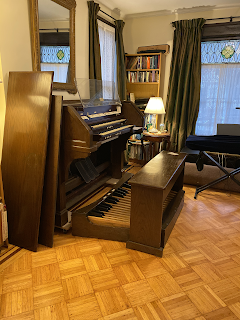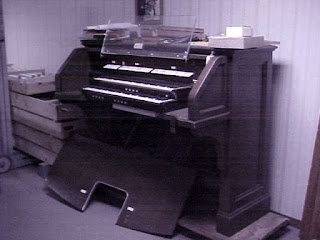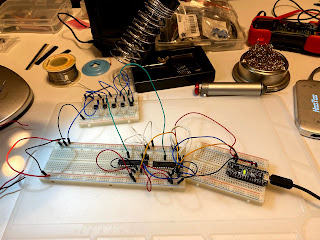And, here it is. The top panel and another bit are leaning against it. The console is sitting on a pair of small dollies so I can pull it around to work on it without tearing up the floor or myself. The pedals don't slot in because the dollies block them - they would normally push in about a foot closer and the bench also.
I've opened it up to have a look around. So much fascinating mechanics, part of me wants to figure it all out and restore it but the rest of me says don't waste time on that, get the organ working electronically :)
There is a lot of dirt to clean off and parts to remove and there will be parts to add. I have the encoder electronics all worked out, but what is needed is a way to detect the keypresses. I prefer at this stage to use the existing mechanism and just read the keypresses off it, but it is rather more complicated than expected.
the pedalboard itself is purely mechanical, wood, and non conductive. At the end of it are a set of wooden pushers wiht felt bottoms, and you just shove it against the organ where there are a row of rods - the things in the very top of the photo. Springs hold them up, and pushing on them rotates them down and swings the rod inside to brush against these little metal whiskers which run through those long narrow board things going horizontally. The boards move back and forth - whiskers could be moved out of range - in response to a widget at the end of each. I can't see where the whisker wires go, it is buried underneath. I think I could use a dental mirror right about now.
Next...
I've opened it up to have a look around. So much fascinating mechanics, part of me wants to figure it all out and restore it but the rest of me says don't waste time on that, get the organ working electronically :)
There is a lot of dirt to clean off and parts to remove and there will be parts to add. I have the encoder electronics all worked out, but what is needed is a way to detect the keypresses. I prefer at this stage to use the existing mechanism and just read the keypresses off it, but it is rather more complicated than expected.
the pedalboard itself is purely mechanical, wood, and non conductive. At the end of it are a set of wooden pushers wiht felt bottoms, and you just shove it against the organ where there are a row of rods - the things in the very top of the photo. Springs hold them up, and pushing on them rotates them down and swings the rod inside to brush against these little metal whiskers which run through those long narrow board things going horizontally. The boards move back and forth - whiskers could be moved out of range - in response to a widget at the end of each. I can't see where the whisker wires go, it is buried underneath. I think I could use a dental mirror right about now.
It looks like the rod pushes the two wires coming from the terminals at the end together - they could be power and ground. In that case what are all the other things for?
That thick metal rod doesn't appear to be conductive though it is likely it just needs a higher voltage from my multimeter. I don't think it is silver.
Next...





Comments
Post a Comment